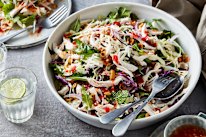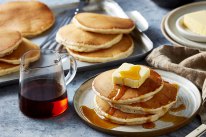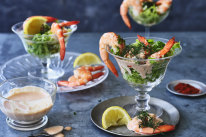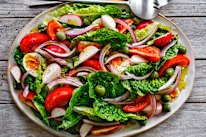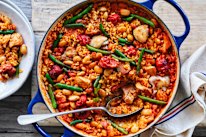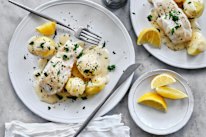How to make Adam Liaw’s foolproof fish burgers with perfect crunchy batter, every time
Tender fish, shattery batter, soft buns, and don’t forget the tartare sauce. Here’s Adam Liaw’s masterclass on how to make the much-loved Aussie classic.
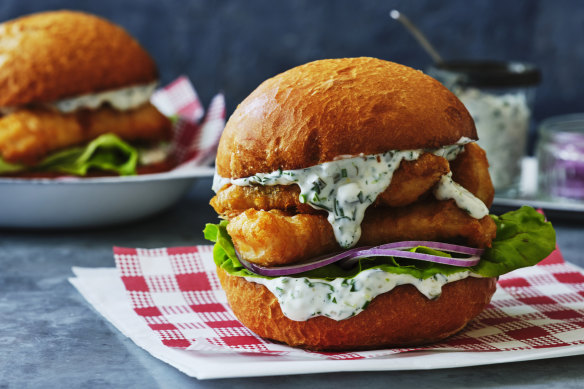
A good fish burger should be a bigger part of our national conversation. Crisp batter, tender fish and soft buns accompanied by a creamy and zingy tartare sauce is the kind of thing Australians cry out for as soon as the weather starts to warm. Here’s how to make the best ones.
Ingredients
500g whiting, flathead or other thin white fish fillets
salt and black pepper, to season
1-2 litres oil for deep frying
6 soft white burger buns, halved
1 head butter lettuce
1 small red onion, shaved into thin rings
20g melted butter
Beer batter
110g (¾ cup) self-raising flour, frozen uncovered overnight, plus extra for dusting (see note)
250ml beer, chilled (see note)
Tartare sauce
300g (1 cup) good quality mayonnaise
juice and grated zest of ½ a lemon
2 spring onions, finely chopped
2 gherkins, finely chopped
1 tsp capers, finely chopped
2 tbsp parsley, finely chopped
2 tbsp dill, finely chopped
2 tbsp chives, finely chopped
Method
Step 1
Cut the fish into pieces slightly smaller than your burger buns and season with salt. Refrigerate uncovered overnight, if possible, but otherwise, move straight to Step 2.
Step 2
Heat the oil to 180C. Sift the frozen flour into a bowl and lightly whisk in the beer to produce a batter about the consistency of pouring cream with lumps still visible in the batter. Using a pastry brush dipped in flour, lightly dust the fish fillets all over with the extra flour. Dip a fillet into the batter, allowing excess to drip off, then lower the fillet into the hot oil. Repeat for the remaining fillets. Fry the fish in batches until golden brown (about 4-5 minutes) and the fish is just cooked. Drain on a wire rack and season with salt.
Step 3
For the tartare sauce, mix the ingredients together in a small bowl.
Step 4
Toast the buns, cut side only, on a grill or frying pan and brush the toasted side with a little melted butter. Place a spoonful of tartare sauce on the base of the bun, lay one or two pieces of lettuce and a few onion rings on top, add enough fish to fill the burger and spoon over more of the tartare sauce. Season with black pepper and cover with the top bun. Serve immediately.
Masterclass
Which fish should I use?
The fish you use is a matter of preference. I like a flaky white fish that is not too firm and – most importantly – has fillets that are not too thick or large. Thick fillets will be even thicker once battered, and when you add the bun, sauce and other ingredients, you’ll end up with a burger that can’t fit into a human mouth, which, to me, is one of the greatest crimes in food.
I like whiting (King George, preferably) or flathead, but you could use garfish, snapper, dory and other fish with similarly thin fillets. Barramundi and ling fillets are often too thick and meaty-textured for a fish burger, but if you like your burgers supersized, feel free to go for those instead.
Tartare sauce?
Tartare sauce is important for a good fish burger. The crisp, savoury fish cries out for a creamy and zingy mayonnaise-based tartare with plenty of pickles and fresh herbs. The pickles add acidity while the herbs add tannins and fragrance. Chopped hard-boiled egg (or hard-boiled yolk) is often included in tartare sauce, but I don’t think it’s necessary for a fish burger.
As an aside, you can pick a good fish and chip shop by its tartare sauce. Commercial squeezy packets? No thanks. A house-made tartare that is somehow even worse than the commercial squeezy packets? Also no thanks. But if you find a chippy near you that makes a good tartare sauce, you’re on a winner.
Beer batter 101
The key to a good beer batter is to ensure you produce as little gluten as possible. Gluten is the elastic, gluey protein that gives good bread its chewy texture. In a batter, too much gluten will make the batter tough, rubbery and thick, and that thickness will also stop it from becoming crisp.
Gluten is formed by taking the proteins glutenin and gliadin, found in wheat flour, and working them in the presence of water and heat. This is what you are doing when you’re kneading a dough. The gluten allows the dough to stretch and catch carbon dioxide released by the yeast, which gives bread its rise.
When making batter, you don’t want to catch that carbon dioxide. Rather, a crisp batter is created when the carbon dioxide expands and escapes from the batter, leaving a thin layer of batter that cooks and crisps in the hot oil.
To limit the gluten in batter, we keep everything very cold. Freezing flour might sound like a bizarre thing to do (and it is) but it was a tip given to me by a tempura chef many years ago. Chilling both the beer and the flour (and mixing the batter in a metal bowl over iced water) will help limit the production of gluten.
You can also add a bit of cornstarch (which does not contain gluten-forming proteins) to reduce the overall amount of protein in the flour mix. I don’t add it to my recipe as I think additional starch can give the batter a slightly gummy texture if it isn’t cooked out well enough. But if you find your batter a little “bready”, you could try adding a little.
Just as important as keeping everything chilled is to keep mixing to a minimum. If you mix the batter enough to remove any lumps of flour, your batter will certainly be over-mixed and have produced too much gluten. A few lumps is preferable to an over-mixed batter.
I use a pastry brush to dust the fillets with flour (another tip given to me by a tempura chef) to ensure the coating is as thin as possible. This allows the batter to stick to the fish without adding too much extra flour that can make the batter doughy.
Why beer?
Beer serves two main purposes in a batter. Firstly, it adds proteins and sugars for flavour, which help produce the Maillard browning reactions that make our food taste better and more complex.
Secondly, the carbon dioxide and stabilising proteins in beer mean that the batter can form a foam. The thin structure of a foam crisps as it cooks, and insulates the fish, which is the key point to battered fish – a crisp, flavourful batter outside with gently cooked fish inside.
Yet another tempura chef once told me (I know I’m referencing a lot of tempura chefs here, but I’ve been quizzing them for years about frying – they are the experts), “Tempura is steamed food. The batter fries on the outside but the ingredients gently steam inside.”
If you don’t want to use beer, you can use sparkling water or a combination of beer and sparkling water instead.
Appears in these collections
The best recipes from Australia's leading chefs straight to your inbox.
Sign upMore:
From our partners
Similar Recipes
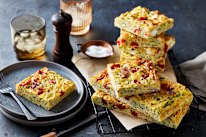
You already love zucchini slice. Adam Liaw explains how to make it even better
- 30 mins - 1 hr
- Adam Liaw

Adam Liaw’s step-by-step guide to making the perfect chicken parmigiana at home
- 30 mins - 1 hr
- Adam Liaw

